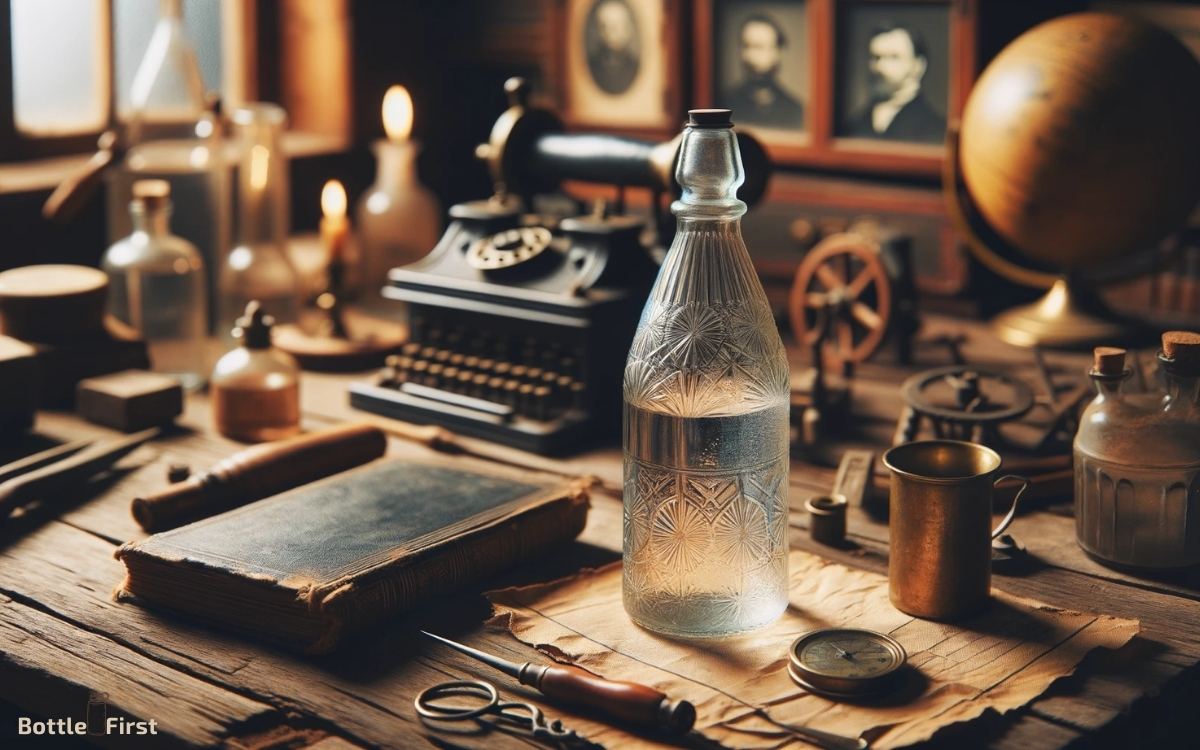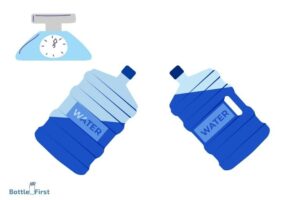When was the Water Bottle Invented? A Brief History!
The water bottle, as we know it today, has its earliest origins dating back to 10,000 B.C.
However, the modern, commercially available water bottle began to emerge in the 20th century, with the first disposable water bottle introduced in the 1960s.
The initial concept of carrying water in portable vessels can be traced to ancient civilizations that used materials like animal skins, gourds, and clay pots.
With advancements in materials and manufacturing:
Unveiling the chronicle of hydration, the water bottle has transitioned from mere utility to a symbol of health and environmental consciousness.

Key Takeaway
Ancient Origins of Water Containers
The ancient origins of water containers date back to early civilizations, where various vessels were crafted to store and transport water.
In ancient Egypt, people used clay pots to store water, and in ancient Rome, aqueducts were built to transport water to cities.
The Indus Valley Civilization also created intricate systems to store and distribute water, showcasing the importance of water containers in early human societies.
These early containers were vital for survival and played a crucial role in the development of civilizations.
The evolution of water containers reflects the ingenuity and resourcefulness of ancient cultures, as they sought efficient ways to manage and utilize this essential resource.
Understanding the historical significance of water containers can provide a sense of belonging and connection to the ancient roots of human society.
Early Human Innovations in Water Storage
Innovations in early human water storage demonstrate the resourcefulness and adaptability of ancient civilizations, shaping their ability to manage and utilize this vital resource.
Early humans developed various methods to store and transport water, including:
- Animal Bladders: Using animal bladders as makeshift water containers allowed for easy transportation of water.
- Clay Pots: The invention of clay pots enabled early humans to store larger quantities of water for extended periods.
- Hollowed Gourds: Hollowed gourds were utilized as natural water vessels, providing a lightweight and easily accessible option for water storage.
These innovative solutions highlight the ingenuity of ancient civilizations in addressing their water storage needs. As these techniques evolved, they paved the way for the emergence of modern water bottles.
Continuing on from these early innovations, the subsequent section will delve into the emergence of modern water bottles.
The Emergence of Modern Water Bottles
When it comes to the emergence of modern water bottles, it’s important to consider the early water containers that paved the way for today’s designs.
Understanding the impact of these innovations on hydration practices can provide valuable insights into the evolution of water bottle technology.
Early Water Containers
You can trace the emergence of modern water bottles back to early water containers used by ancient civilizations.
These early containers were crucial in the development of portable vessels for carrying water and other liquids. They paved the way for the evolution of the modern water bottle.
Some key points to consider about early water containers include:
- Materials: Ancient civilizations used a variety of materials such as animal skins, gourds, and hollowed-out wood to create water containers.
- Design: The design of these early containers varied based on the available resources and the specific needs of the civilization.
- Purpose: These containers were primarily used for storing and transporting water, reflecting the importance of this resource in ancient societies.
Understanding the early water containers provides insight into the origins and development of the modern water bottle.
Impact on Hydration
The evolution of ancient water containers laid the groundwork for the modern water bottle, revolutionizing the way you hydrate on a daily basis.
The emergence of modern water bottles has significantly impacted hydration practices, providing convenience and accessibility like never before.
Take a look at the table below to see the evolution of water containers and how it has influenced your hydration habits:
| Ancient Water Containers | Modern Water Bottles |
|---|---|
| Gourds and animal skins | Reusable plastic, stainless steel, or glass bottles |
| Limited portability | Easy to carry, reusable, and durable |
| Limited capacity | Various sizes to suit individual needs |
The transition from ancient water containers to modern water bottles has not only made staying hydrated more convenient but has also become an integral part of your daily routine, ensuring you feel connected and in tune with the modern world.
Industrial Revolution and Mass Production
The Industrial Revolution and mass production had a significant impact on consumption habits, leading to the widespread availability and affordability of water bottles.
This technological advancement in manufacturing allowed for the mass production of water bottles, increasing accessibility to clean drinking water.
However, it also raised environmental concerns due to the proliferation of single-use plastic bottles and their negative impact on the environment.
Impact on Consumption Habits
During the Industrial Revolution and the rise of mass production, water bottles became more widely available, leading to a significant shift in consumption habits.
This shift had a profound impact on how people accessed and consumed water, influencing daily routines and behaviors.
- Convenience: With the availability of mass-produced water bottles, it became easier for individuals to carry water with them throughout the day, encouraging increased hydration and overall well-being.
- Environmental Concerns: The mass production of water bottles also raised concerns about environmental impact, leading to a growing awareness of sustainability and the development of eco-friendly alternatives.
- Health Consciousness: The widespread availability of water bottles prompted a greater focus on health and fitness, as individuals began to prioritize hydration and incorporate it into their lifestyle.
These changes in consumption habits reflect the broader societal shifts brought about by the Industrial Revolution and mass production.
Technological Advancements in Manufacturing
Inventors revolutionized manufacturing processes during the Industrial Revolution, leading to the mass production of water bottles.
The advent of new technologies like the steam engine and mechanized production systems enabled the efficient creation of glass and metal water bottles on a large scale.
This era marked a significant shift from traditional handmade production to the utilization of machinery, vastly increasing the output and availability of water bottles.
Mass production allowed for more affordable pricing, making water bottles more accessible to a wider population.
The Industrial Revolution also facilitated the development of standardized manufacturing processes, ensuring consistency and quality in the production of water bottles.
These technological advancements not only transformed the manufacturing industry but also played a crucial role in shaping consumption habits, making water bottles a ubiquitous and indispensable item in everyday life.
Environmental Implications and Concerns
With the advent of mass production during the Industrial Revolution, you can see a significant impact on the environment due to the increased manufacturing of water bottles.
This has led to several environmental implications and concerns, including:
- Resource Depletion: The mass production of water bottles requires large amounts of natural resources such as oil for plastic production and water for bottle filling.
- Energy Consumption: The manufacturing process and transportation of water bottles consume significant amounts of energy, contributing to carbon emissions and climate change.
- Waste Generation: The disposal of plastic water bottles contributes to the growing issue of plastic pollution, impacting ecosystems and wildlife.
These concerns highlight the need for sustainable alternatives and responsible consumption to mitigate the environmental impact of water bottle production.
The Rise of Plastic Water Bottles
The rise of plastic water bottles began in the mid-20th century, revolutionizing the way people consume and transport water.
Plastic bottles provided a convenient and portable way to carry water, leading to a significant shift in consumer behavior. The durability and lightweight nature of plastic made it a popular choice for on-the-go hydration.
This convenience factor contributed to the widespread adoption of plastic water bottles, especially for activities like sports, travel, and daily commutes.
As the demand for bottled water increased, so did concerns about the environmental impact of plastic waste. While plastic bottles offered convenience, they also raised issues related to sustainability and pollution.
The rise of plastic water bottles represents a transformative shift in how water is packaged and consumed, shaping modern habits and attitudes toward hydration.
Innovations in Sustainable Water Bottle Design
Your sustainable water bottle design has seen significant innovations in recent years. Manufacturers have been actively working to create more sustainable and eco-friendly options for consumers like you.
Some of the most notable advancements include:
- Use of biodegradable materials: Companies are now utilizing biodegradable materials such as plant-based plastics and compostable fibers to create sustainable water bottles.
- Enhanced durability: Innovations in sustainable bottle design have led to increased durability, ensuring that your bottle can withstand everyday wear and tear.
- Improved insulation: Sustainable water bottles now come with enhanced insulation features, keeping your beverages at the desired temperature for longer periods.
These innovations not only provide you with a more sustainable option but also offer improved functionality and performance, making them a desirable choice for environmentally conscious consumers like yourself.
Conclusion
So, you now know the fascinating history of the water bottle. From ancient clay pots to modern plastic bottles, humans have been finding innovative ways to store and carry water for thousands of years.
Next time you take a sip from your reusable, sustainable water bottle, think about the long journey of innovation and progress that has led to the convenient hydration solution in your hand.
It’s amazing how far we’ve come!






